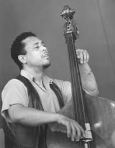This is an excerpt of my remarks for the June 19, 2014, Jazz Diplomacy event sponsored by Natixis at the National Archives.
Into a Black, Brown, and Beige World
Into a Black, brown and beige world went US Jazz Ambassadors, including: Dizzy Gillespie, Dave Brubeck, Benny Goodman, Louis Armstrong and Duke Ellington. Leading with jazz and spreading democracy in sound, our finest musicians traveled to far-away places — Africa, the Middle East, Asia and Eastern Europe — collaborating and integrating with various people of the world for more than two decades, beginning in the mid 1950s.
Oh, they had been overseas before. Armstrong and Ellington had toured abroad in the early 1930s — just after the Stock Market Crash of 1929 — but this was different. These were no ordinary gigs. These musicians, who had established themselves as cultural icons at home, were now tasked with representing the nation abroad. Indeed, this integrated bunch whose home country was in the midst of an intense Civil Rights struggle, was being called upon to save the nation’s image, globally. They did that and so much more.
“Ike Gets Dizzy“
The idea of Jazz Ambassadors was a collaboration between President Dwight D. Eisenhower and Harlem Representative Adam Clayton Powell, Jr., after the successful multi-year Cold War tour of Porgy and Bess. 
 Powell, who was married to organist Hazel Scott, was able to secure Dizzy Gillespie for the first official tour (Middle East, 1956). In the midst of racial strife that seemed sure to tear the nation apart, Dizzy Gillespie was a bold and necessary choice for leading the new venture.
Powell, who was married to organist Hazel Scott, was able to secure Dizzy Gillespie for the first official tour (Middle East, 1956). In the midst of racial strife that seemed sure to tear the nation apart, Dizzy Gillespie was a bold and necessary choice for leading the new venture.
But why jazz?
Jazz had an established global audience, internationally recognized talent, and was an art form indigenous to the United States. Primarily an instrumental music, jazz did not require lyrics, understanding the English language was not required for participation or appreciation. A “stealth weapon” of the Cold War, jazz was a relatively new art form so exceptional, it could rival the centuries of excellence of ballet and classical music embedded in European cultures and the Soviet Union. (Satchmo, 28) What’s more, jazz musicians weren’t hung up on race or ethnicity; jazz culture was and is inherently integrated, musicians sought and seek the best sounds. Jazz is an inclusive form, welcoming as many instruments as can be played.
Created by Americans of African descent living in the US, jazz could simultaneously combat racial strife at home and promote diversity abroad. Supporting jazz meant acknowledging the cultural value of its historically marginalized populace, an effort that was in direct opposition to the realities as witnessed in contemporary news accounts.  Seen through the lens of jazz, the United States was not the racist, materialist society others deemed it to be; instead, the US was a leader, a modern, progressive nation unified though its diversity, a disruptive innovator in a world wedded to custom.
Seen through the lens of jazz, the United States was not the racist, materialist society others deemed it to be; instead, the US was a leader, a modern, progressive nation unified though its diversity, a disruptive innovator in a world wedded to custom.
Prelude to Chaos
The 1950s were turbulent years in the US. Senator Joseph McCarthy was closely associated with the era known as the “Red Scare” and took the ideological divide between democracy and communism to levels that were positively surreal. He turned his glance inward, accusing fellow countrymen of betrayal; and widened the gulf between races by castigating the socially conscious of every hue. The US involvement in the Korean War (1950-53) divided that country along ideological lines.
Separate, however, was not equal; so said the Supreme Court in its 1954 decision in Brown v Board but society had other ideas. In the summer of 1955, a young boy from Chicago, Emmett Till, was murdered in cold blood because witnesses thought they heard him whistle at a white co-ed during a summer visit to Mississippi.
 Despite their own damning testimony, his killers were acquitted. That December, Rosa Parks refused to give up her seat to a white patron on a Montgomery, Alabama, bus and so launched a dignified nonviolent economic attack that lasted more than 380 days.
Despite their own damning testimony, his killers were acquitted. That December, Rosa Parks refused to give up her seat to a white patron on a Montgomery, Alabama, bus and so launched a dignified nonviolent economic attack that lasted more than 380 days.
Segregation has been US social custom. Despite the Supreme Court’s ruling, Governor Orval Faubus of Arkansas sent the National Guard to prohibit nine children from integrating public school.  The Little Rock Nine eventually received protection from President Eisenhower who sent troops to protect the students’ right to matriculate. The insidiousness of this violence and the complexities of justice — these blues — were written indelibly into our cultural history with “Fables of Faubus” by Jazz Ambassador Charles Mingus.
The Little Rock Nine eventually received protection from President Eisenhower who sent troops to protect the students’ right to matriculate. The insidiousness of this violence and the complexities of justice — these blues — were written indelibly into our cultural history with “Fables of Faubus” by Jazz Ambassador Charles Mingus.
Jazz and Life
Jazz had various forms but each reflected life in a unique way. Bebop musicians such as — Dizzy Gillespie, Charlie Parker, Thelonious Monk, Roy Haynes, and JJ Johnson — brought forth a sound that illuminated virtuosity, was harmonically complex, and faaaaast! Bebop was rebellious, unsettling, and energetic. Domestically, it reflected the struggle for Civil Rights. Internationally, it appealed to youth and many overseas who struggled (psychologically, at least) and imagined life under a more liberal order.
The swing music of the big-band era with its steady, reliably placed beats, no longer seemed sufficient for capturing the velocity of social change. Incredulous, unnerving social contradictions, were expressed in bebop with sounds that were at once fiercely violent, emotionally dense, and cathartic. In one sense, musicians seemed to intellectualize the struggle; creatively processing its absurdities and indignities. Yet, swing privileged collaboration, promoted individuality through improvisation, and suggested social cohesion in ways bebop did not.
Innovation through Jazz
Legendary producer, NEA Jazz Master George Wein understood integration on a variety of levels. He knew we needed a variety of jazz forms and he wanted as many people as possible to engage the music. In 1954, when the United States seemed to be on the brink of social collapse, George began a series of annual outdoor jazz festivals in Newport, Rhode Island; and the rest, as they say, is history.  The idea of jazz festivals democratized the way we experience music. Through jazz festivals, George gave us a template for active engagement, audience growth and development, rotating leadership, and private/public partnership. Jazz reached through socio-economic barriers, dealt with the depths of emotional pain and injustice forthrightly, celebrated the triumph of the human spirit, and made even the most unlikely collaborations possible.
The idea of jazz festivals democratized the way we experience music. Through jazz festivals, George gave us a template for active engagement, audience growth and development, rotating leadership, and private/public partnership. Jazz reached through socio-economic barriers, dealt with the depths of emotional pain and injustice forthrightly, celebrated the triumph of the human spirit, and made even the most unlikely collaborations possible.
This was music to the State Department’s ears. George had a model that worked and a sizable, reliable network of musicians. The alliance between George Wein’s Festival Productions and the US Department of State was ideal. Musicians were able to expand the audience for their music and develop artistic alliances that would otherwise not be possible. The State Department was able to enter geopolitical spaces in black, brown and beige areas, bridge gaps in understanding, and forge meaningful alliances by bearing culture — not arms.
What’s more, jazz is self-regenerating. Whether swing, bebop, avant-garde, or cool — jazz adapts to change, embraces difference, and enables individuality through freedom of expression. Jazz is always modern and always relevant; it is agile. As Cultural Historian Albert Murray wrote, “The more any art form changes… the more it should be able to fulfill its original function.” (Hero, 72)
The tours of Eastern Europe and the Soviet Union were arguably the most successful. Musicians adapted to their ever-changing environments and audiences.  They formed musical alliances, booked gigs and gave interviews in local markets. The music was sold bootleg and broadcast on the radio. Jazz became the sound of democracy and where jazz went, so too did commerce. Jazz had broad social appeal and reached the “man in the streets” not just those in elite circles of power. This was revolutionary — average citizens the world over had the chance to experience an art form that spoke to them directly and encouraged them to speak back. Jazz availed people of the possibilities inherent in individual self-expression.
They formed musical alliances, booked gigs and gave interviews in local markets. The music was sold bootleg and broadcast on the radio. Jazz became the sound of democracy and where jazz went, so too did commerce. Jazz had broad social appeal and reached the “man in the streets” not just those in elite circles of power. This was revolutionary — average citizens the world over had the chance to experience an art form that spoke to them directly and encouraged them to speak back. Jazz availed people of the possibilities inherent in individual self-expression.
* * *
The, now historic, Jazz Ambassador tours ended in the mid 1970s. The program left an indelible impact on all those involved; from diplomats whose jobs were made easier because of the way jazz commanded respect and made conversations flow, to musicians who hungered for the breadth of exposure to new sounds and interactions with new audiences, to average citizens who recognized their voice.
Follow the Music
Jazz tours continue today in modified form. Cultural presentation programs are now commonplace but it is no coincidence jazz was an early leader. As a response to economic disaster at home, musicians revealed themselves as entrepreneurs and expanded their networks of supporters and sponsors decades before terms like “social media” or “globalization” would enter into our collective vocabulary. Moreover, the blues — the deep feeling of contrasting emotions transmitted through sound, captured and sustained in jazz — is what connects people to the music and invites them into the shared creative, expressive, space and facilitates the formation of emotional communities. People from far and wide travel to be close to the music and what’s more, jazz musicians will travel to reach the people; they seek each other. As an inherently inclusive art form, jazz works because musicians absorb the sounds of local environments and through seamless collaboration, extend and enhance understanding.
Our efforts to engage the black, brown and beige of the world today — those in our own country and in emerging economies — will require lessons learned best through jazz: collaboration, listening, improvisation, and leading. Follow the music, it will teach you everything you need to know.






